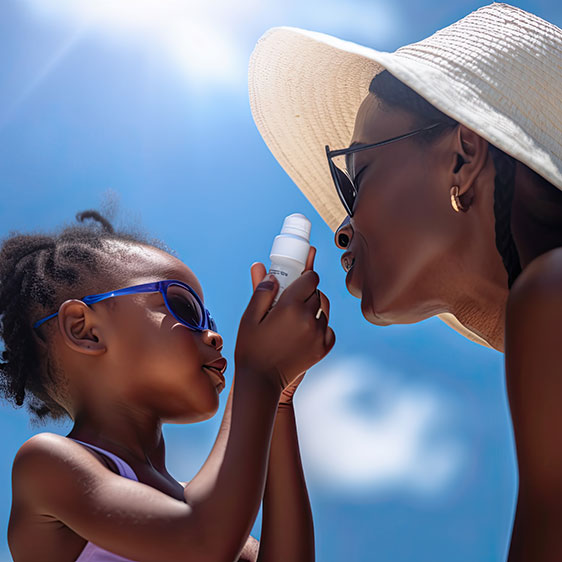
Summertime is the season for enjoying the beach and outdoor fun. And for those who don’t protect themselves, it is also the season for sun damage.
“Every year at this time, I talk to my patients about the importance of protecting their skin to avoid more complications down the line,” says board-certified internist Dr. Emi Rendon Pope with Beaufort Memorial Lowcountry Medical Group. “The sun’s ultraviolet rays are well known to lead to skin damage, early aging and skin cancers."
Dermatologists have indicated that most skin damage actually occurs in our younger years, making sun protection important not only for adults, but for children, too.
What Sun Damage Looks Like
“Our skin tells the story of how much time we’ve spent in the sun,” Dr. Rendon Pope says. “The signs of sun damage are more numerous and common than you might think.”
Here are just a few of the ways your skin reveals how much sun exposure you’ve had:
- Brown spots. Also called “age spots,” brown spots are not caused by age at all but by the sun. Depending on how much time you’ve spent in the sun, these spots can show up at any time in life.
- Broken blood vessels. Often attributed to aging, burst blood vessels can also be caused by sun damage. These blood vessels are often visible on the skin and may be swollen to the touch.
- Freckles. Although not a sign of sun damage, freckles are caused by sun exposure. You’re more likely to have them if you have red or blonde hair and light-colored eyes.
- Hyperpigmentation. Intense skin irritation can cause hyperpigmentation, in which spots with some dark and light patches appear on certain areas of skin. There may also be red discoloration.
- Tanning. The idea of the “healthy tan” has long been debunked. Tans can be harmful, regardless of your skin color and tone. They can speed up the aging of your skin and increase your risk for skin cancer, including melanoma, the most dangerous form of skin cancer.
- Wrinkles. The ultraviolet light from the sun destroys our skin’s natural collagen and elastin and, over time, causes fine lines in places most often exposed to the sun.
Protecting Your Skin: Sunscreen, Covering Up and Finding Shade
It’s important to use sunscreen, but choosing the right type of sunscreen matters just as much. For darker skin tones, it is recommended to use a sunscreen with an SPF of at least 30 and an SPF of at least 50 for lighter skin tones. Darker skin tones should use tinted sunscreen with iron oxide in it to protect from visible light — not just the UVA rays. Regardless of waterproof claims and long wear, all sunscreens must be reapplied every two hours when you’re spending the day in the sun.
According to the American Academy of Dermatology Association (AADA), sunscreen does not contain any harmful substances, despite what you may hear. The only people who should not use sunscreen are children younger than 6 months old, who should stay in the shade. Other children should only use mineral sunscreen, those with either titanium dioxide or zinc oxide.
Read More: The Truth About Sunscreen
When applying sunscreen, don’t overlook these sensitive areas:
- Back of your neck
- Lips (invest in a lip balm with an SPF)
- Tops of your feet
- Your ears
- Your scalp
No sunscreen can protect you 100%, so complement your sunscreen with other preventive measures. The Food and Drug Administration recommends wearing clothes that keep you covered, such as:
- A wide-brimmed hat that covers your face, ears and neck
- Wraparound sunglasses that block UVA and UVB light for eye protection, as the eyes can also burn, leading to permanent issues
- Lightweight clothing to cover up exposed skin
Finally, learn to love the shade. Find an umbrella or covered patio to stay out of direct sunlight or stay indoors when UV rays are strongest, usually between 10 a.m. and 4 p.m.
Read More: Staying Safe in the Summer Sun: 5 Tips for Cancer Patients
Reversing the Signs of Sun Damage
It’s difficult to fully reverse sun damage, so protecting your skin is a good first step to ensuring healthy skin as long as possible. However, dermatologists and other health care providers can help fix sun damage to some extent with:
- Chemical peels. Chemical peels remove the outer layer of skin, which can improve your skin’s appearance and reduce wrinkles.
- Cryotherapy. This treatment involves freezing age spots or other areas of skin with liquid nitrogen, an extremely cold substance.
- Laser resurfacing. Laser resurfacing removes the skin’s outer layer and boosts collagen production to help the skin appear smoother.
- Microdermabrasion. This procedure combines a freezing spray with a special brush to remove sun-damaged skin. As skin regrows, it has a smoother appearance.
- Topical prescription retinoid products. Retinoids promote collagen production and can reduce inflammation related to sun damage.
Early Detection Matters Most
Skin cancer is the ultimate sign of sun damage, so regular skin cancer screenings will protect you far more than a special treatment or cream.
The AADA estimates that over 3 million people in the U.S. have skin cancer, including basal cell and squamous cell carcinomas. Providers can treat both types of skin cancer effectively when diagnosed in their early stages.
Melanoma is the deadliest type of skin cancer and causes about 20 deaths every day in the U.S. As with other cancers, treatment is more successful if melanoma is identified in its early stages before it reaches the lymph nodes.
Actinic Keratosis: A Sign of What Could Come?
Skin cancer screenings, whether performed by you or a provider, can also identify actinic keratosis, the most common type of precancerous skin disease seen by dermatologists. The condition often appears as a red, brown or pink patch on the skin regularly exposed to the sun and its UV rays. This area may be itchy or painful. Commonly affected areas include the hands, lips and face.
The Skin Cancer Foundation reports an estimated 58 million Americans will be diagnosed with actinic keratosis in their lifetime. If left untreated, it can develop into squamous cell carcinoma. However, treatments are often effective and successful, and most people who get treated for actinic keratosis don’t develop skin cancer.
With all forms of skin cancer and precancerous skin disease, as the saying goes, “An ounce of prevention is worth a pound of cure.” Protecting your skin from damage and making an effort to avoid overexposure will make a difference in the long run and could prevent you from getting skin cancer or precancerous skin disease altogether.

Need help protecting your skin? Schedule an appointment today with a Beaufort Memorial primary care provider.

